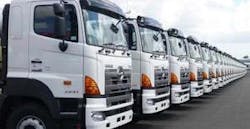But that’s all rapidly moving to a new level. A number of government initiatives, for instance, aim to make highways part of the sensor network and knit those sensors into vehicle intelligence. According to the Smart Road Operations at the Virginia Tech Transportation Institute and the Virginia Green Highway Initiative, efforts there are underway to develop standards for a wireless highway. All vehicles will potentially use the technology to operate more safely together and individually. Trucks may use the technology to get information about slopes and traffic so they can operate more efficiently.
Hino Insight 2.0, focuses on providing customers with improved total cost of ownership, better vehicle uptime and better user experiences. The updated platform aims to help customers save money, increase safety and improve operations by providing even more information to optimize fleet operations.
For manufacturers, there is plenty of potential in this increasingly connected vehicle environment. For instance, a manufacturer of replacement truck transmission and drivetrain components probably has a pretty good view into the supply chain, at least as far as the distributor or perhaps even the fleet operator or retailer. But not yet all the way to the vehicle. However, in a rough winter like the one most of North American has just endured, transmissions in plow vehicles and other driveline components are probably failing at a higher than normal rate.
What if on-vehicle sensors could detect incipient transmission failures or repeated torque overloads, gather that information from users and combine it to predict how many replacement bearings and clutches to put in process in anticipation of need? That would add a whole new level of sensitivity to predictive software. It could also gather valuable field data, which could be incorporated quickly into product upgrades.
The point is that the IIoT is not only exciting and transformative at any given site or location, it is even more transformative and exciting when all the parts and pieces finally begin to connect -- even when they are moving down the highway!





